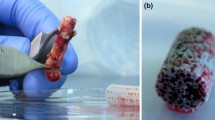Abstract
External fixators of serious fractures could be an attractive substrate on which microorganisms can accumulate. Therefore, this study aimed to develop a suitable method for enabling the simulation of a real situation when osteosynthetic fixation material is open for the potential threat of bacterial attack. Agar-based media represented human tissue, and the metallic pin characterized the screw in the fixation. Various types of agar, supplements, and contamination strategy by Staphylococcus aureus were tested. The influence of the initial bacterial concentration was also examined. Surfaces were observed by scanning electron microscopy (SEM), and all results were compared. Brain Heart Infusion Agar with the Egg Yolk Tellurite Emulsion was established in a transparent test tube as a suitable system for enabling the good interpretability of bacterial contamination in the pin’s surroundings. Pin contamination has been found to be an appropriate approach for testing microbial growth, rather than agar surface contamination, which distorted obtained results. A lower initial colony forming units (CFU) provided better clarity of the test. SEM observation of the pin surface was comparable with the visual evaluations in the test tubes. Results were assembled for positive and negative control samples as well. Screening method for the most common bacteria S. aureus has been standardized and developed. This experimental setup could also be a useful tool for surface modification with antibacterial properties testing.







Similar content being viewed by others
References
Arciola CR, Campoccia D, Speziale P, Montanaro L, Costerton JW (2012) Biofilm formation in Staphylococcus implant infections. A review of molecular mechanisms and implications for biofilm-resistant materials. Biomaterials 33:5967–5982
Arenas MA, Perez-Jorge C, Conde A et al (2013) Doped TiO2 anodic layers of enhanced antibacterial properties. Colloids Surf B: Biointerfaces 105:106–112
Barros J, Melo LDR, Poeta P, Igrejas G, Ferraz MP, Azeredo J, Monteiro FJ (2019) Lytic bacteriophages against multidrug-resistant Staphylococcus aureus, Enterococcus faecalis and Escherichia coli isolates from orthopaedic implant-associated infections. Int J Antimicrob Agents 54:329–337
Darouiche RO (2004) Treatment of infections associated with surgical implants. N Engl J Med 350:1422–1429
Elias CN (2008) Biomedical applications of titanium and its alloys. Biological Materials Science
EN ISO 7218 (2007) Microbiology of food and animal feeding stuffs — General requirements and guidance for microbiological examinations. International Organization for Standardization, Geneva
Fang C, Wong TM, Lau TW, To KKW, Wong SSY, Leung F (2017) Infection after fracture osteosynthesis – part I: pathogenesis, diagnosis and classification. J Orthop Surg 25:1–13
Furkert FH, Soensen JH, Arnoldi J et al (2011) Antimicrobial efficacy of surface-coated external fixation pins. Curr Microbiol 62:1743–1751
Fux CA, Costerton JW, Stewart PS et al (2005) Survival strategies of infectious biofilms. Trends Microbiol 13
Garrett TR, Bhakoo M, Zhang Z (2008) Bacterial adhesion and biofilms on surfaces. Prog Nat Sci 18:1049–1056
Hall-Stoodley L, Costerton JW, Stoodley P (2004) Bacterial biofilms: from the natural environment to infectious diseases. Nat Rev Microbiol 2
Harris LG, Richards RG (2006) Staphylococci and implant surfaces: a review. Injury 37:3–14
Jennison T, McNally M, Pandit H (2014) Prevention of infection in external fixator pin sites. Acta Biomater 10:595–603
Liu L, Xu Y, Cui F, Xia Y, Chen L, Mou X, Lv J (2018) Monitoring of bacteria biofilms forming process by in-situ impedimetric biosensor chip. Biosens Bioelectron 112:86–92
Mah TFC, O’Toole GA (2001) Mechanisms of biofilm resistance to antimicrobial agents. Trends Microbiol 9:34–39
Maki DG, Weise CE, Sarafin HW (1977) A Semiquantitative culture method for identifying intravenous-catheter-related infection. New Engl J Med 296(23):1305–1309
Niinomi M (2003) Recent research and development in titanium alloys for biomedical applications and health-care goods. Sci Technol Adv Mater 4:445–454
Stewart PS, William Costerton J (2001) Antibiotic resistance of bacteria in biofilms. Lancet 358:135–138
Stoodley P, Sauer K, Davies DG et al (2002) Biofilms as complex differentiated communities. Annu Rev Microbiol 56:187–209
Tande AJ, Patel R (2014) Prosthetic joint infection. Clin Microbiol Rev 27:302–345
Trampuz A, Zimmerli W (2006) Diagnosis and treatment of infections associated with fracture-fixation devices. Injury 37(Suppl 2):S59–S66
Trampuz A, Osmon DR, Hanssen AD et al (2003) Molecular and antibiofilm approaches to prosthetic joint infection. Clin Orthop Relat Res 414:69–88
Yano MH, Klautau GB, da Silva CB, Nigro S, Avanzi O, Mercadante MT, Salles MJC (2014) Improved diagnosis of infection associated with osteosynthesis by use of sonication of fracture fixation implants. J Clin Microbiol 52(12):4176–4182
Zimmerli W (1997) Experimental foreign-body associated infections. Med Mal Infect 27:188–194
Funding
This study was funded by the Czech Health Research Council [project no. 15-27726A].
Author information
Authors and Affiliations
Corresponding author
Ethics declarations
Conflict of interest
The authors declare that they have no conflict of interest.
Ethical approval
This article does not contain any studies with human participants performed by any of the authors.
Informed consent
N/A
Additional information
Publisher’s note
Springer Nature remains neutral with regard to jurisdictional claims in published maps and institutional affiliations.
Rights and permissions
About this article
Cite this article
Pruchova, E., Kosova, M., Jarolimova, P. et al. A qualitative method for testing the antimicrobial ability of osteosynthetic fixation material by simulating in vitro contamination by Staphylococcus aureus. Folia Microbiol 65, 679–686 (2020). https://doi.org/10.1007/s12223-020-00774-9
Received:
Accepted:
Published:
Issue Date:
DOI: https://doi.org/10.1007/s12223-020-00774-9




